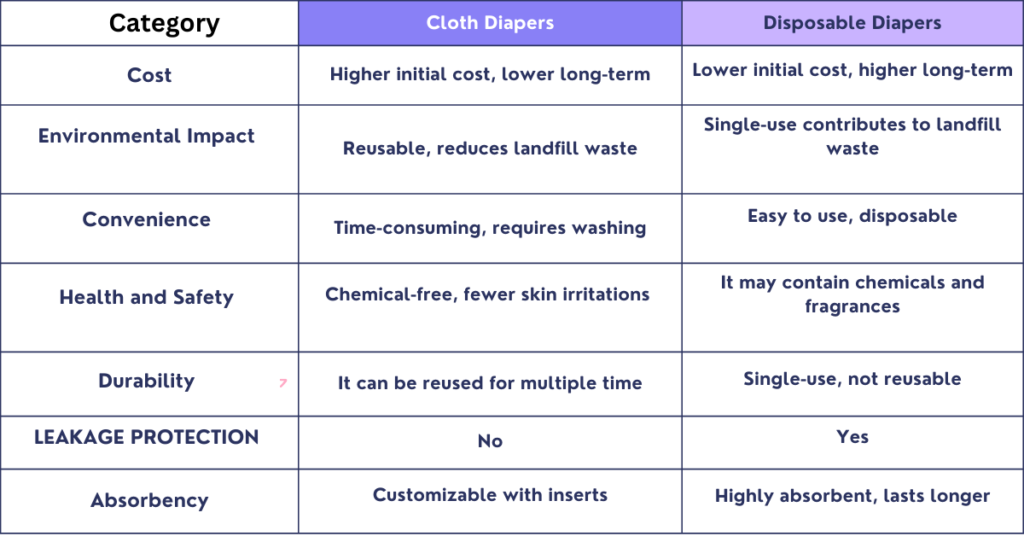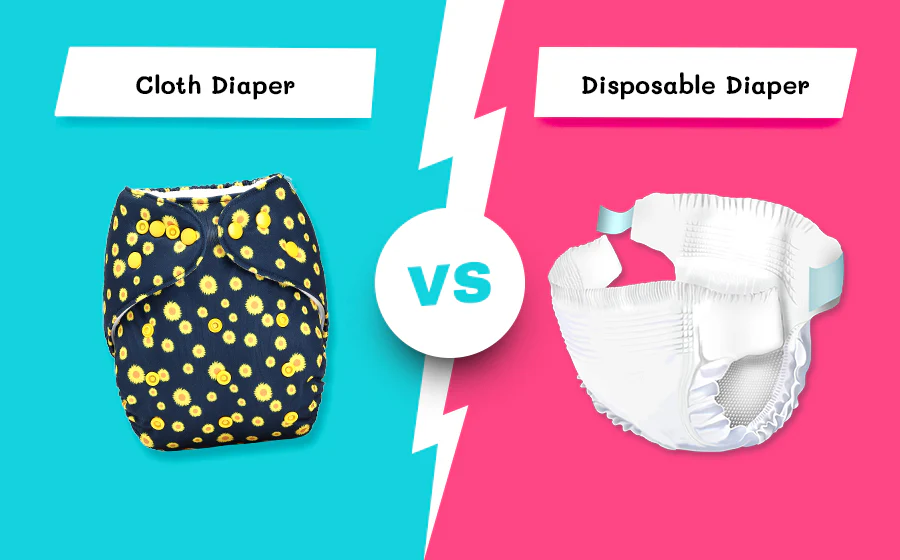When it comes to diapering your baby for new parents. the decision between cloth diapers vs disposable diapers is a tough one and the choice you make can impact your baby’s comfort, your budget, the safety of your baby’s skin, and even the environment. This article dives deep into the pros and cons of both diapers offering you a comparison so you can make your choice.
Cloth Diapers
Cloth Diapers have been used for centuries and made a comeback in recent years due to environmental concerns and cost-effectiveness. These diapers are made using fibers, some materials or a combo of both of them. They are washable, reusable, and can be compared with disposable. cloth diapers are more weak to leaks. To help prevent blowouts consider using a diaper cover made to go over the cloth diaper for extra protection and comfortable for long time use.
Types of Cloth Diapers
There are several types of cloth diapers including:
- Flat Diapers: A flat diaper is a type of cloth diaper made from a single, large, or rectangular piece of fabric usually cotton. flat diapers are versatile and can be easily folded in any type to fit the body size of a baby and make them comfortable it.
- Prefold Diapers: A prefold is a cloth diaper style that features cotton or another natural fabric like bamboo or hemp sewn as a rectangle with more layers in the middle (wet zone). Most prefolds feature 4 layers of fabric on each side and 8 in the middle.
- Fitted Diapers: Shaped like disposable diapers, but require a cover. Similarly to flats and pre-folds, fitted cloth diapers require an outer waterproof diaper cover to contain the leaks.
- Pocket Diapers: Have a pocket to insert absorbent pads. A pocket diaper is a cloth diaper style that has a pocket opening between the outer waterproof fabric (PUL) and the inner fabric that touches the baby so that you can place absorbent inserts inside. Where the opening is doesn’t really matter too much, that comes down to personal preference.
- All-in-One Diapers: Combine absorbency and waterproof layers in one piece. An All-In-One (AIO) diaper is a cloth diaper style that has a waterproof exterior and an absorbent interior all sewn together so that it is one piece. It is simple to wash-and-wear cloth diaper available and is the closest cloth diaper to a disposable that you will find.
- Hybrid Diapers: Can be used with disposable or reusable inserts. These Diapers are also called reusable cloth diapers. Hybrids consist of an outer reusable cover and a disposable insert inside.
Pros of Cloth Diapers
- Cost-Effective: One of the significant benefits of Cloth Diapers vs Disposable Diapers is the cost. Although the initial investment is higher, they can be reused for multiple children, saving you money in the long haul.
- Eco-Friendly: Cloth diapers can be washed and reused, reducing the amount of waste that ends up in landfills.
- Skin-Friendly: Cloth diapers are made from natural materials, which are generally gentler on a baby’s skin. They are less likely to cause rashes or irritation compared to disposables.
- Customizable: With various designs and materials, cloth diapers offer more customization in terms of absorbency and fit, making them suitable for different stages of your baby’s growth.
Cons of Cloth Diapers
- Initial Cost: The upfront cost of purchasing cloth diapers can be high, making them less accessible for families on a tight budget.
- Laundry Requirements: Cloth diapers need to be washed frequently, which can be time-consuming and may increase your water and electricity bills.
- Bulkiness: Cloth diapers tend to be bulkier than disposables, which can make it challenging to find clothing that fits well over them.
- Learning Curve: Using cloth diapers effectively requires a bit of learning and practice, especially when it comes to folding and securing prefolds or flats. and even cause diaper rash sometimes.
Are Cloth Diapers Better?
Many parents choose cloth diapers for their environmental benefits and long-term cost savings. The decision largely depends on your lifestyle, your willingness to manage the laundry, and how much you value sustainability. If you’re committed to reducing waste and don’t mind the extra work, modern cloth diapers could be the better option for your family. Cloth diaper user and mother of two Raya Hegeman-Davis thinks maybe it has. “I’m sure my parents must have used cloth diapers when I was a baby, but when I told them I was going to use cloth they thought I was crazy.
Disposable Diapers
Disposable diapers have been the go-to choice for most parents due to their convenience and ease of use. They are designed to be used once and then thrown away, offering a hassle-free diapering solution, especially for busy parents or those without access to laundry facilities.
Types of Disposable Diapers
- Standard Disposable Diapers: The most common type, designed for regular use and available at a cheap price. it has a high capacity of absorbent so that your child is comfortable.
- Eco-Friendly Disposable Diapers: Made from more sustainable materials and designed to be more biodegradable. Ecological diapers are a more environmentally friendly alternative to traditional disposable diapers.
- Swim Diapers: Specifically designed for swimming diapers are intended to be non-absorbent, which allows urine to pass through, while solids remain properly contained using the leak guards.
- Overnight Diapers: Thicker and more absorbent, Overnight diapers, also known as nighttime diapers or night diapers, are designed to prevent leakage, blowouts, and over-soaked diapers while the baby is sleeping for long periods of time.
- Disposable Diapers also reduce diaper changes per day. It is best if you have at least 20 diapers per day. It prevents extra laundry and saves electricity and water.
Pros of Disposable Diapers
- Convenience: Disposable diapers are incredibly convenient, especially for busy parents. There’s no need to wash or dry them, just use and throw them away.
- Highly Absorbent: Modern disposable diapers are designed to be highly absorbent, keeping your baby dry for longer periods, which can be especially useful during the night.
- Easy to Use: There’s no learning curve with disposable diapers. They come ready to use and can be quickly put on and removed.
- Less Bulk: Disposable diapers are generally less bulky than cloth diapers, making it easier to find clothing that fits well over them. and they also have a waterproof cover.
Cons of Disposable Diapers
- Cost Over Time: The cost of disposable diapers vs cloth can add up over time. Since they are single-use, you’ll need to keep buying them, which can be expensive in the long haul.
- Environmental Impact: Disposable diapers contribute significantly to landfill waste. The environmental cost of producing and disposing of them is much higher compared to cloth diapers.
- Chemicals: Some disposable diapers contain chemicals like dioxins and fragrances, which can irritate sensitive baby skin.
- Dependency on Supply: You always need to have a steady supply of disposable diapers, which can be inconvenient if you run out unexpectedly. and sometimes it may not be best suited for long time travel.
Are Disposable Diapers Better?
Disposable diapers are ideal for parents who prioritize convenience and are willing to pay for it. They are particularly useful for travel, outings, and situations where you may not have access to laundry facilities. However, their environmental impact and ongoing cost are significant factors to consider.
Tips for Choosing the Right Diaper
- Assess Your Lifestyle: Consider how much time and effort you can dedicate to diapering. If you have a busy schedule, disposables may be more practical.
- Budget Considerations: Compare the initial and long-term costs of both options. Cloth diapers may require a higher upfront investment but can save you money in the long run.
- Environmental Concerns: If reducing your environmental footprint is important to you, cloth diapers are the greener choice.
- Baby’s Comfort: Consider your baby’s skin sensitivity. Cloth diapers are often better for babies with sensitive skin, but modern disposables are also designed to be gentle.
Are Cloth Diapers or Disposable Diapers Better for the Environment?
When it comes to cloth diapers vs disposable diapers debate on environmental impact, cloth diapers generally come out ahead. Disposable diapers contribute significantly to landfill waste, taking hundreds of years to decompose. The production of disposable diapers also requires a lot of resources, including water, energy, and raw materials like wood pulp and plastic. In contrast, cloth diapers can be reused multiple times, significantly reducing waste. However, they do require frequent washing, which can increase water and energy usage.
Using energy-efficient washing machines, line drying, and eco-friendly detergents can further minimize the environmental impact of cloth diapers. In contrast, the cost of disposable diapers vs cloth in terms of environmental damage is much higher, making cloth diapers a more sustainable option in the long haul.
Since cloth diapers are reusable, you won’t have piles of disposable dirty diapers in the trash, which some believe may be more environmentally friendly. While disposable diapers are time-saving they don’t provide the quality of reusable diapers.
Comparison Chart: Cloth Diapers vs Disposable

Choosing between cloth diapers and disposable diapers is a personal decision that depends on various factors, including your lifestyle, budget, and environmental concerns. Each option has its own set of pros and cons, and what works best for one family might not work for another. By considering all the aspects discussed in this article, you can make an informed decision that aligns with your values and needs.
Cloth Diapers vs Disposable Diapers: FAQs
A: On average a newborn may go through 8 to 12 diapers per day. This number can vary depending on factors such as feeding habits and the baby’s digestive system. Newborns tend to have frequent bowel movements, so it’s important to keep them dry and comfortable by changing their diapers regularly.
A: Cloth diapers should be changed every 2 to 3 hours, or immediately after the baby soils them. Unlike disposable diapers, cloth diapers don’t have super absorbent polymers, so they may not hold moisture as long. Frequent changes help prevent diaper rash and keep the baby comfortable.
A: Cloth diapers are often considered better than disposable diapers for several reasons:
Environmental Impact: They are reusable, which significantly reduces landfill waste.
Cost Savings: Over time, they are more cost-effective than disposables.
Skin-Friendly: Made from natural fibers, they are less likely to cause rashes or allergic reactions.
Customizability: You can adjust the absorbency with inserts, making them versatile for different situations.
A: Cloth diapers are generally cheaper in the long run, despite the higher initial investment. The cost of disposable diapers adds up over time, as they need to be purchased continuously until the baby is potty trained. In contrast, cloth diapers can be reused for multiple children, further reducing the overall cost.







